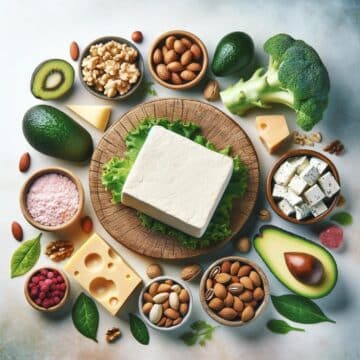Most chocolate and chocolate-flavored things out there are loaded with sugar and not keto, but cocoa powder is an incredible keto ingredient that lets us still eat chocolate! Cocoa powder is very nutritious and has many positive effects on your heart and brain, and even your mood! There are a few similar cocoa-related products out there, so read here to learn the difference between them all and how to use them in keto desserts.
A Quick Recap of the Ketogenic Diet
If you’re here, you are probably pretty familiar with the basics of the ketogenic diet now, but if you’re not, no worries and welcome!! As a quick recap, let’s review that as ketogenic dieters, we eat in a way that maximizes fats. We eat a high ratio of fats to carbohydrates, keeping carbs under about 50 grams a day. Using fats as the primary source of fuel for the body keeps it in a state called ketosis, which can have a lot of benefits for our health. Take a look over here if you’re new to keto and want to learn more!
Satisfying Your Sweet Tooth: Keto Desserts and Chocolate
With keeping daily carbs below 50 grams, it might seem impossible to eat any sweets, which are usually loaded with sugar and carbs. If you love baking and treats after dinner, don’t worry because dessert on keto is definitely possible! We just have to be creative and conscious with our keto recipes and take net carbs into account. Certain carbs are not counted in our carb totals for the day because they do not raise blood sugar. Non-impact carbs as they’re called come from fiber and some sugar alternatives. Only the other types of carbs, which are called impact carbs, affect blood sugar, and count towards our carb totals as “net carbs.” So as long as our keto desserts have more non-impact than impact carbs, they’re good!
Chocolate on Keto? Yes, with Keto-Friendly Cocoa Powder!
Ahhh, the beloved chocolate. Although most chocolate bars and products out there are full of sugar and not keto, there’s good news! We can use two baking ingredients: cocoa powder and cacao powder. Cocoa and cacao are keto and are incredibly useful tools for keto baking and desserts! Cocoa powder allows you to make chocolate-flavored keto desserts without all of the carbs that usually come along with chocolate. Hooray for keto chocolate!
What Makes Cocoa Powder Ideal for Keto?
Cocoa comes from the fruit of a tropical tree that produces large cacao pods with seeds called cacao beans inside. To make cocoa powder, the seeds are fermented, dried, and roasted, then pressed to remove most of their fat, which is cacao “butter.” The remaining solids get ground to produce cocoa powder, which is typically twelve to fifteen percent fat. To make a bar of chocolate, the cocoa powder would be recombined with the cocoa butter and sugar. But for us, this plain keto cocoa powder is what we can use to make things taste chocolatey!
The Lowdown on Keto Cocoa Powder's Nutritional Profile
First, let’s talk about the nutritional breakdown of cocoa powder that makes it keto compliant. Cocoa powder is about 29% fat, 52% carbohydrates, and 19% protein. Per 100g, it has approximately 13.7g fat, 8.7g of which is saturated. The total carbohydrates per 100g are 54.3 g, but 33.2g of those carbs come from fiber. So overall there are only about 21.1g net carbs. These might seem like high numbers, but if we think about a tablespoon, there is only 1.13g net carbs. Cocoa also has a notable amount of protein, with 19.6g protein per 100g cacao. In terms of nutrients, cocoa powder is one of the foods most abundant in magnesium, which is good for heart and bone health, and it’s also high in iron.
Cocoa powder is a superfood!
Beyond cocoa powder being a great keto dessert ingredient, it has a seemingly endless list of potential nutritional benefits. You might often hear of chocolate being touted as a healthy food by pop culture media. These claims are all thanks to the healthy properties of cocoa powder!
Cocoa powder is most known for its antioxidant properties and its positive effects on the cardiovascular system. It has high amounts of polyphenols, specifically flavanols, which are powerful antioxidants. The flavanols in cocoa powder have also been shown to dilate blood vessels, reduce blood pressure, inhibit platelet activity, and improve blood flow. So cocoa powder can be beneficial for people with poor cardiovascular health or those who are at risk of heart disease. An interesting fact is that in countries such as Spain, Mexico, and Italy, where the cocoa powder is consumed frequently as drinking cocoa, there are fewer instances of cardiovascular disease!
Boost Your Brain and Mood with Keto Cocoa Powder
As if that didn’t sound good enough, studies have also shown cocoa powder to prevent nerve damage in the brain through its antioxidant properties. Flavanols are absorbed into the blood and have been shown to accumulate in parts of the brain related to learning and memory, like the hippocampus. Some studies have even demonstrated cocoa powder to improve working memory and cognitive performance.
Cocoa can improve your mood too! People reaching for chocolate when they are sad or stressed is not just psychological; it can really help. One way cocoa does this is through its cardiovascular effect of improving blood flow to the brain. Fresh blood and oxygen up there is the first step to a mood boost! But cocoa also has theobromine, a molecule very similar to caffeine. Theobromine in cocoa powder provides a mild stimulant effect on the central nervous system, but much less than what caffeine does. Instead, theobromine affects the peripheral nervous system a bit more, helping to relax smooth muscle. This light brain activation and physical relaxation can be the perfect combination to boost your mood!
Choosing Between Keto Cocoa and Cacao Powder for Your Diet
No, that’s not a typo! There is a similar ingredient out there called cacao powder instead of cocoa powder, which we have been talking about so far. We’ll soon see why cocoa powder is more relevant for baking, but cacao powder is very similar. It is made from the cacao bean just like cocoa powder, but the difference with cacao is it doesn’t get roasted and the pressing to remove the cocoa butter is done at a low temperature. By not heating the cacao, the natural enzymes are preserved.
So which is better? Cocoa or cacao?
The less processed a product is, the more nutrients it has and the more potential nutritional power. Since cacao powder is not treated at high heat, it has higher levels of flavanols and more powerful effects on your health. Being less processed and deteriorated, also means it has more fiber and calories than cocoa powder, and generally more fat as well. It’s also important to know that the “cocoa” sold in stores is often sweetened and sometimes even has powdered milk added so it can be used as a hot chocolate beverage. Always look carefully at the ingredients list when you go to buy cacao or cocoa!
“Dutch processed” vs. natural cocoa
Now if you’re looking at the ingredients on your bag or box of cocoa powder, you might notice it says “Dutch processed” or “processed with alkali.” To make things slightly more complicated, there are actually two forms of cocoa powder. “Dutch processed” cocoa means it has been processed with an alkalizing material. This is generally a potassium carbonate solution that decreases the acidity of the cocoa powder, making it taste richer in chocolatey flavor and less acidic and bitter. This process also makes the color of Dutch-processed cocoa darker.
The Science Behind Keto Cocoa Powder in Baking
The neutralization of the acidity is super relevant for us to know about for our keto baking‼ Baking typically utilizes the reaction of an acidic ingredient with a basic ingredient such as baking soda to produce rising. Since the cocoa powder is chemically neutral and no longer acidic after Dutch processing, it does not react with baking soda, and it is not able to help things rise.
Mastering Keto Baking with the Right Cocoa Powde
If the chemical stuff is confusing, don’t worry! All you need to know for your keto baking is that natural cocoa powder (not Dutch processed) is usually used in recipes with baking soda because together they react and produce rising. So natural cocoa powder plus baking soda for things like cakes, cupcakes, brownies, or muffins. In the US the widely sold regular unsweetened Hershey’s cocoa powder and Ghirardelli cocoa powder are both the natural type.
On the other hand, Dutch processed (aka alkalized) cocoa is useful for things like keto cookies, keto fudges, puddings, or other desserts that do not require much rising. Keto chocolate candy, icing, and keto ice cream would also work well with Dutch processed. Or even chocolate mousse or chocolate butter. So many options If you want to use Dutch-processed cocoa for its richer chocolatey flavor and still want to make something that rises, all you have to do is make sure there’s another acidic ingredient in your recipe to react with the baking soda. This could be vinegar, lemon, or even buttermilk. Another option is to use baking powder, which provides the leavening all by itself.
If you want to use cacao powder in baking, you can do so by substituting it 1:1 for natural cocoa powder. Remember that like natural cocoa powder, it will not be as rich in flavor or dark in color as the Dutch-processed, and it has the same rising power.
It’s great to have a helpful tool of cocoa powder to allow us to make chocolate-flavored desserts that are still keto! And we have so many options right here, from chocolate bars to a low-carb black forest cake to black and white keto sponge cake!










Cherry says
50g of carbs and under is NOT Keto. 15g of carbs and under is actual Keto. So many fakes and grifters out there, trying to cash in with their nonsense!
Marky says
I just purchased Cocao Barry extra brute powder and can't find any nutritional info. I just started keto and I now see conflicting reports on carb amounts. I'm wondering if I can use your info in hopes that the nutritional info is acurate?
Tisa says
Hi, Marky. Wish I could help but I don't know the brand. Sure, if it's cocoa powder, use the general cocoa powder nutritional info, either on our site or google.
Best regards.
Ruth Rehm says
Tisa, Thank you for this information about the difference between cocoa and cacao powder. I have been using the cacao powder mainly as my powdered chocolate for desserts and drinks.
I also appreciate your sharing your wonderful recipes.
Thank you.